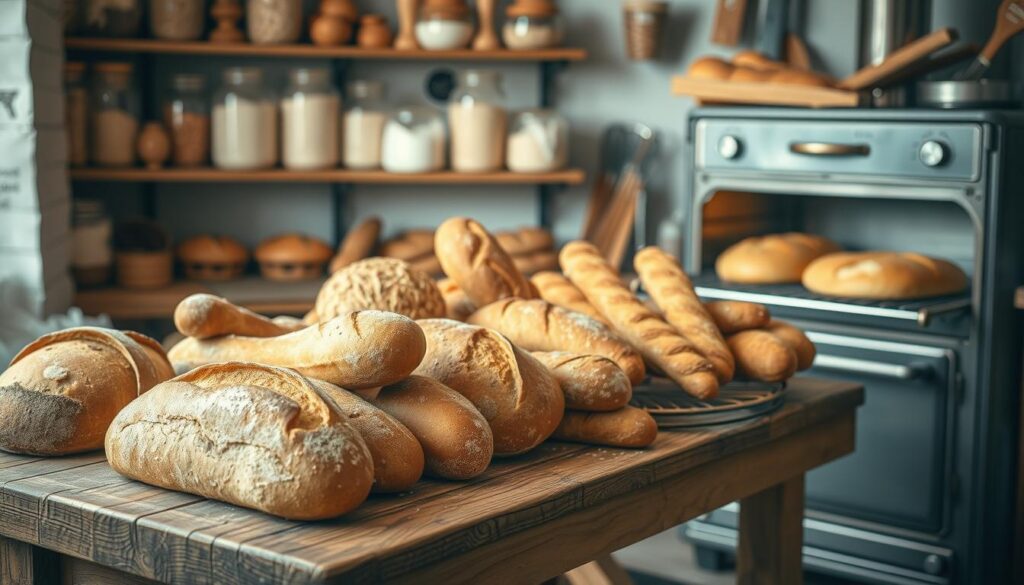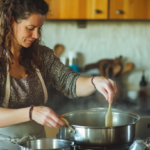Imagine the scent of fresh bread in your home. It’s not just for you but also for many happy customers. This might seem like a dream, but it’s within reach. Consider Jennifer’s story. She was a teacher by day, but she also baked bread at night. She turned her kitchen into a bakery one night each week. Her hobby of making sourdough bread soon became a small business.
She started baking for friends and family. First, it was just one loaf. Then she made up to 90 items per session. Eventually, she baked 180 items every weekend. Her home bakery grew from a hobby to a business in just a year.
Starting a home bakery can fit your life, even with a full-time job. Jennifer’s story is not unique. With hard work, anyone can start a bread business. But, it’s important to get health department certificates and understand Cottage Food Laws. Following health codes is key. This makes sure you can sell your bread legally.
Whether you’re learning to bake or expanding your bakery, the journey is full of challenges and rewards. Let’s look at the steps you need to take. We’ll cover legal stuff and how to make your baking love a business success.
Key Takeaways
- A home-based bakery can start as a side-hustle, offering flexibility in time commitment and gradual growth.
- Starting small with baking for friends and family can lay the foundation for a larger homemade bread business.
- Understanding and complying with local Cottage Food Laws is essential for legal operations.
- Investing in a strong business plan is crucial for long-term success and profitability.
- Utilizing social media platforms like Facebook and Instagram can significantly increase customer visibility and sales.
Understanding the Basics of Starting a Home Bread Business
Starting a homemade bread business can be very rewarding. But, you must understand the basics to succeed. This includes making a detailed business plan, finding your market spot, and knowing the costs.
The Importance of a Business Plan
A solid business plan is vital for a homemade bread business’s success. Studies show that a detailed plan increases success chances by 50%. It should outline your goals, target market, and a SWOT analysis for the bread market.
Good planning lets you set achievable goals. It also helps you stay within your budget. This way, you can grow your business smoothly and strategically.
Finding Your Niche in the Bread Market
Finding your niche is key in the competitive home baking world. Offer unique breads to stand out from big bakeries. Start small with one or two specialties to build a good reputation.
Know what locals want by analyzing their demographics and shopping habits. While cakes and pastries are popular, a unique bread niche could make you stand out.
Initial Investment and Budgeting
Knowing the initial costs for starting is crucial. A home bakery starts between $1,000 to $5,000. These costs come from regulations and equipment needs.
Focus your budget on quality ingredients and marketing rather than rent or building. This approach reduces financial stress. Use tools like Jotform Store Builder to start online cost-effectively. It offers many features to help with customer interactions.
Legal Requirements for a Home-based Bakery
Starting a home-based bakery can be a great idea, but knowing the rules is key. In this part, we talk about important legal advice for home bakeries. This includes understanding licensing needs, getting to know cottage food laws, and following food safety rules.
Licensing and Permits
First things first, you need to know about bakery licensing requirements. These rules are different in each state. Some places ask for special licenses, others don’t for small businesses. Getting a Home Bakery License usually takes 2 to 4 weeks.
Home bakeries need to pass a health check to see if they are clean and safe. This check is tough; you have to meet all the requirements to pass. The cost for licenses and the changes you might need to make, like extra sinks or better fans, can add up.
Cottage Food Laws: What You Need to Know
Cottage food laws let you sell your homemade baking legally. But there’s a limit on how much you can make, somewhere between $10,000 to $50,000 per year, and it depends on where you live. You can sell at places like farmer’s markets and online, but you need to follow your state’s rules. Kitchens get checked for things like how cold the fridge is and if it’s clean.
Getting started might cost more if you need new equipment or have to make changes to your kitchen. So, it’s really important to know the cottage food laws in your state.
Food Safety Standards
Making sure your kitchen follows food safety regulations is super important for your bakery at home. Keeping everything clean and food at the right temperature keeps customers safe. A good digital kitchen scale, which might cost $15 to $20, helps you follow rules about weighing and labeling what you bake.
Health checks look at how clean your kitchen is and how you store food. Keeping up with food safety rules is not just about avoiding fines. It’s also about earning your customers’ trust. Following these safety rules is a big deal for keeping your bakery running right.
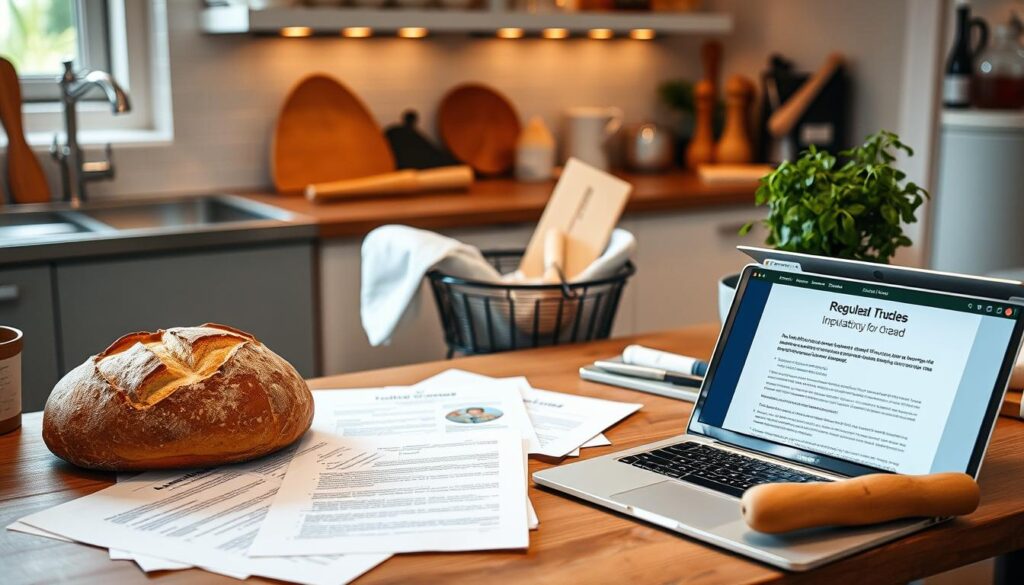
How to Start a Home Bread Business
Starting a home bread business is rewarding but needs planning. You have to follow legal steps. Let’s dive into how to register your bakery. We’ll also touch on zoning laws that might affect your business.
Steps to Register Your Business
First, decide if you want to be a sole proprietor or an LLC. After choosing, follow these steps to get registered:
- Check Naming Requirements: Make sure your business name is unique and follows your state’s rules.
- Register Your Business: Submit the required forms to your state’s office. This may include a DBA form for trade names.
- Obtain an EIN: Get an Employer Identification Number from the IRS. This is for hiring employees or opening a business bank account.
- Secure Licenses and Permits: You might need a business license, food manager license, and clearance from the health department.
- Set Up Financial Systems: Open a business bank account to keep track of your finances.
Understanding Zoning Laws
Home bakery zoning laws are important. They dictate where and how you can run your bakery. Here are some points to consider:
The average startup cost for home bakeries is $500 to $5,000. This includes equipment, ingredients, and licenses.
- Residential Zoning: Check if your area allows home-based businesses. Some places limit commercial activities in residential zones.
- Operating Hours: Know any rules about when your business can operate. This helps avoid neighborhood issues.
- Health and Safety Regulations: Make sure your kitchen meets health standards. This includes how you store food and keep things clean.
- Annual Sales Cap: Some states limit how much a home bakery can earn, often under $50,000 a year.
To start a home bread business, focus on registration and zoning laws. These steps help build a successful bakery right from your home.
Creating a Product Line: Homemade Bread Recipes Easy
Starting a homemade bread business means focusing on easy recipes first. This method makes the process simpler and guarantees consistent success. Making unique bread at home is the goal.
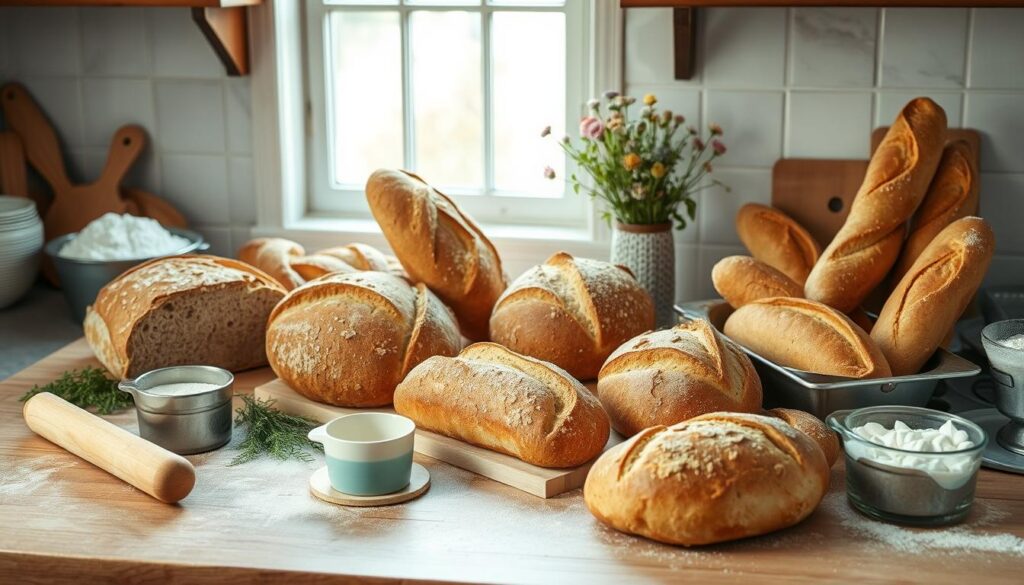
Popular Bread Types to Offer
Offering popular bread types grabs customer interest. Consider these options:
- Sourdough Bread: Always a hit, especially in local stores.
- Hamburger Buns: Great for summer BBQs and neighborhood events.
- Bagels: Offer them in several flavors, like plain or everything.
- Gluten-Free Options: With about 40% of customers preferring gluten-free, it’s a smart move.
- Cinnamon Rolls: A top pick on social media, often in demand.
Experimenting with Flavors and Recipes
Trying new flavors and recipes is crucial, whether you’re a newbie or a pro. Here’s what you can try:
- Incorporate Local Ingredients: Use local, organic items to draw in those who value quality.
- Specialty Items: Mix up your offerings with both savory and sweet breads.
- Custom Orders: Let customers order bread with their favorite flavors.
- Holiday Specials: Seasonal breads can boost sales and interest.
By choosing easy, yet creative recipes, you’ll attract folks searching for tasty and different bread choices. Always start with simplicity when making bread for your growing business.
Essential Equipment for Baking Bread at Home
Starting your home bakery means getting the right gear. This part talks about needed tools for beginners and more advanced items for those stepping up their baking game.

Basic Baking Tools
To begin, you’ll need these basic baking tools:
- Mixing bowls: Aim for a mixing bowl that holds at least 5 liters. Stainless steel is durable and easy to wash.
- Measuring tools: Get a digital scale for metric and imperial units. A measuring jug of at least 1 liter is also useful.
- Rolling pin: A rolling pin should be no less than 40 cm long.
- Baneton: A regular 23 cm round baneton fits about 1 kg of dough, helping it keep its shape while proving.
- Baking sheets and trays: Reusable silicone sheets are better than baking paper. A baguette tray should have four slots for about 600 grams of flour recipes.
- Baking stone: A baking stone or granite tile costs less than $10. It’s great for even baking heat.
- Dough scraper: It’s useful for cutting and handling dough with ease.
Advanced Equipment for Scaling Up
As your bread business grows, consider these advanced tools to work more efficiently:
- Stand mixers: Needed for handling big dough batches. Mixers range from 300W to 1500W. Typical bowl size is 4.6 liters, though 2.6 kg of dough is a safer max amount.
- Proofing cabinet: Keeps dough at the perfect temperature for even results.
- Cast iron pans: Also known as Dutch ovens. Look for at least 23 cm wide. Prices vary from $35 on Amazon to $200+ for top brands like Le Creuset.
- Baking ovens: A Rofco oven is good for making lots of bread.
- Thermometers: They make sure dough is the right temperature (24 to 26°C) for consistent bread.
Choosing quality bakery equipment can really up your game and product quality. It’s key for growing your bread-making business successfully.
Setting Up Your Home Kitchen for Bread Production
Creating an efficient home kitchen setup for baking is key to a successful home bread business. It’s about finding the right balance of space, storage, and how you use the area. Here are tips to optimize your bakery space for top productivity and efficiency.
Start by looking at your workspace layout. A typical work table in home bakeries is about 72 inches long. However, a 60-inch table works well too, especially in smaller spaces. You might even start with your kitchen table before getting a dedicated one. Being flexible at this stage is very helpful.

Storage is super important too. Use different-sized plastic tubs to organize ingredients like nuts, seeds, and grains. You can also turn a small room, like a laundry room, into a storage area. Baking tools need their own place too, on shelves or in bins. Having baker’s racks or speed racks is smart, especially for proofing boards and cooling sheet pans.
Keeping things safe is a big deal. Store flour at least 6 inches off the ground to follow health rules. If you’re using up to 150 pounds of flour a week, you need to manage it well. You might even need to remodel, adding sinks or separate areas, to pass health inspections.
Over six years, buy things bit by bit to keep costs down. The biggest buys are usually in the last two years, when your business is more stable. Start small and grow as needed to avoid spending too much all at once. This way, you make sure you have what you need without breaking the bank.
Optimizing your home bakery space means you’re set up for making professional-grade bread. With the right setup, you can meet customer demand and follow all the rules. This leads to a successful home bread business.
Marketing Your Homemade Bread Business
Marketing your home bakery is key to success and finding loyal customers. Use strategies like creating a brand, using social media, and having a great website. These will help you reach more people and sell more.
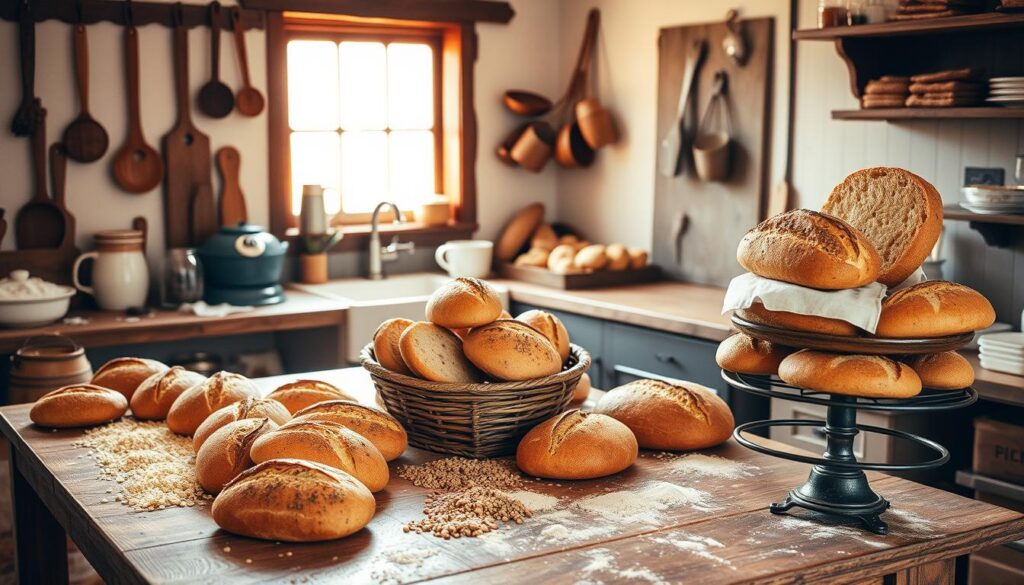
Building a Brand Identity
A strong brand sets you apart from others. Define what makes your bread unique. Maybe it’s the natural ingredients, the special flavors, or how it’s made. Pick a catchy name and a logo that shows what you stand for.
Design packaging that tells your brand’s story. Using eco-friendly materials or adding personal notes can make your product special. Being consistent with your branding on all platforms helps people remember you.
Leveraging Social Media
Social media is crucial for bakers today. Use Instagram, Facebook, and Pinterest to share your bread. Show what you make, how you make it, and happy customers to connect with people.
Being active and responding quickly to comments matters. Run giveaways and partner with local influencers to grow. 80% of successful home bakeries say Instagram helped them a lot.
Creating a Website for Online Sales
A good website is vital for selling bread online. It should be easy to use, work well on phones, and have a good e-commerce setup. Show your products, prices, and how to order clearly. Use clear pictures and descriptions to draw buyers in.
Have an “About Us” page to tell your story and show your love for baking. Use SEO smartly to rank higher in search results. Keywords like “marketing a home bakery” and “online bread sales” can bring more visitors. A good website helps sell more and builds your reputation.
Building a Customer Base
Building a strong customer base is key to your homemade bread business’s success. You can connect with locals by showing up at events and offering great bread deals. This helps create and keep a loyal bunch of buyers.
Targeting Local Markets
Focusing on local market targeting helps grow your audience. Start by checking out nearby areas to see what people like and need. Handing out flyers at schools, stores, and libraries can raise your profile. Also, being active on social media and local food groups keeps people updated on your special bread promotions.
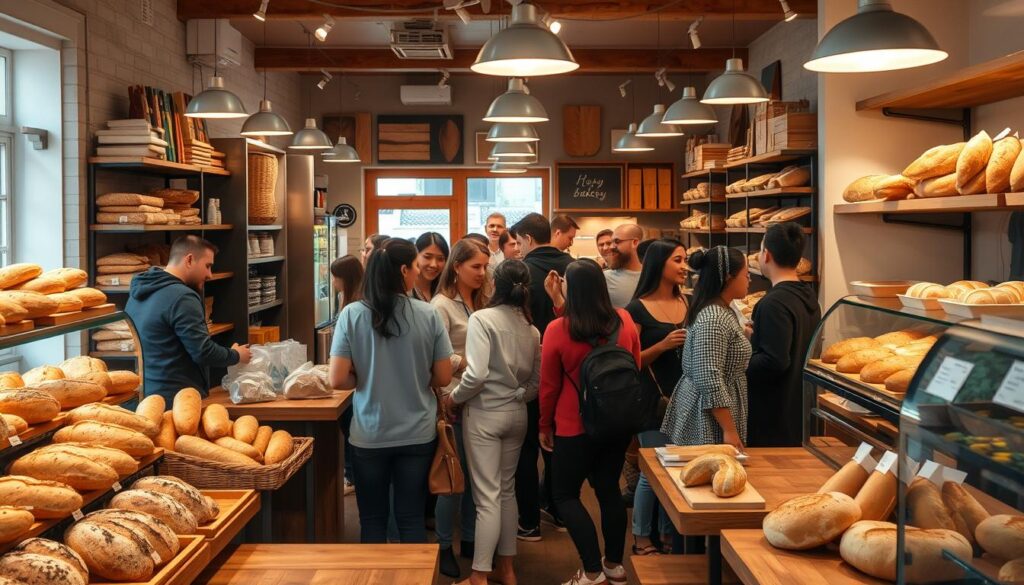
Participating in Farmers’ Markets and Local Events
Joining farmers’ markets and food events is a great move. You can talk directly to folks and get immediate feedback. This not only increases sales but also spreads the word about your bakery. Offering samples and unique bread promotions at these spots can draw in new clients.
Offering Promotions and Discounts
Deals and discounts always bring in customers. You could start a program that rewards people for referring your bakery to others. Seasonal sales or special offers for holidays can boost your buyer count. Deals like “Buy One, Get One Free” or first-time buyer discounts can spark interest and boost sales in your local area.
By aiming for local markets, taking part in community happenings, and using bread deals, your bakery can build a loyal customer circle. This full plan ensures steady support and helps your bread business flourish.
Pricing Your Homemade Bread for Profit
Setting the right price for your homemade bread is crucial for profit margins in baking. To price bakery items, multiply the ingredient costs by 5. For example, if it costs 56 cents ($0.56) in ingredients for a batch, use that calculation for pricing. Also, consider each loaf’s labor cost, usually around 17 cents ($0.17).
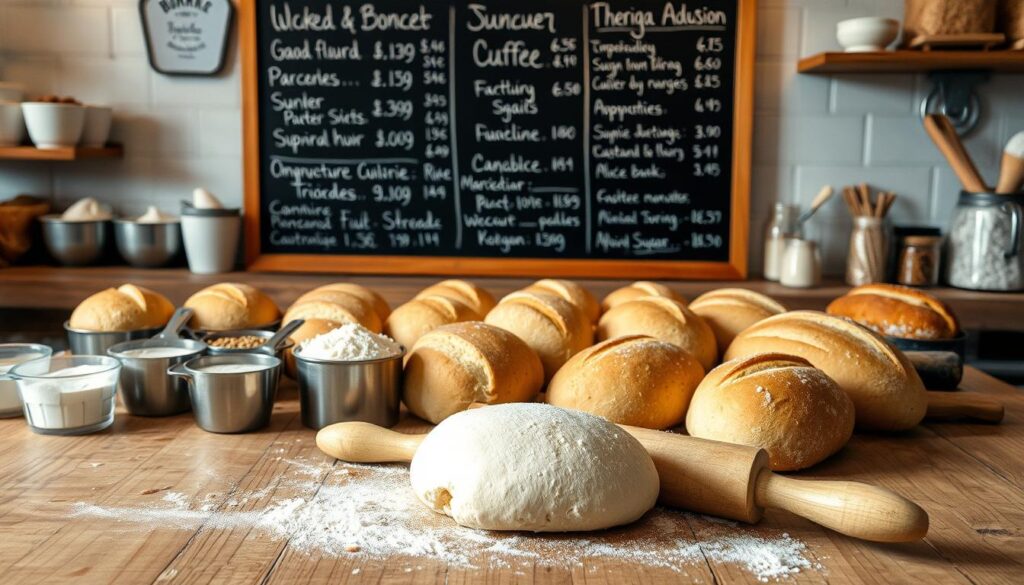
- Figure out the total production cost per loaf. Say it’s 73 cents ($0.73) for a white loaf, including time and labor.
- Add a profit index to your costs. Starting with an index of 1.7 adds a 70% margin to the base price. This keeps the balance between making a profit and keeping it affordable.
- Add in service costs, like labor for service (24 cents or $0.24) and card transaction fees (5 cents or $0.05). These total 29 cents ($0.29) for supply cost.
- If you deliver, factor in delivery costs. Calculate this by dividing the total daily delivery cost by the number of deliveries to stay efficient.
It’s important to price in a way that matches what people are willing to pay and your product’s value. Try to make sure half your customers buy for quality, not just price. Use tools like Cakecost.net for a strategy that fits your numbers. Ignore big box store prices since home bakeries operate differently.
An effective pricing strategy looks at your costs, the profit margins in baking you want, and what the local market is like. Keep trying different prices. You’ll find a balance that brings in profit and keeps customers happy.
Packaging and Labeling your Bread
When looking at bakery packaging ideas, think about design and following labeling requirements for homemade bread. Good packaging does two things: it keeps your bread safe and makes your brand stand out. A great bakery label can make your baked goods seem more valuable. This could boost sales by 30%.
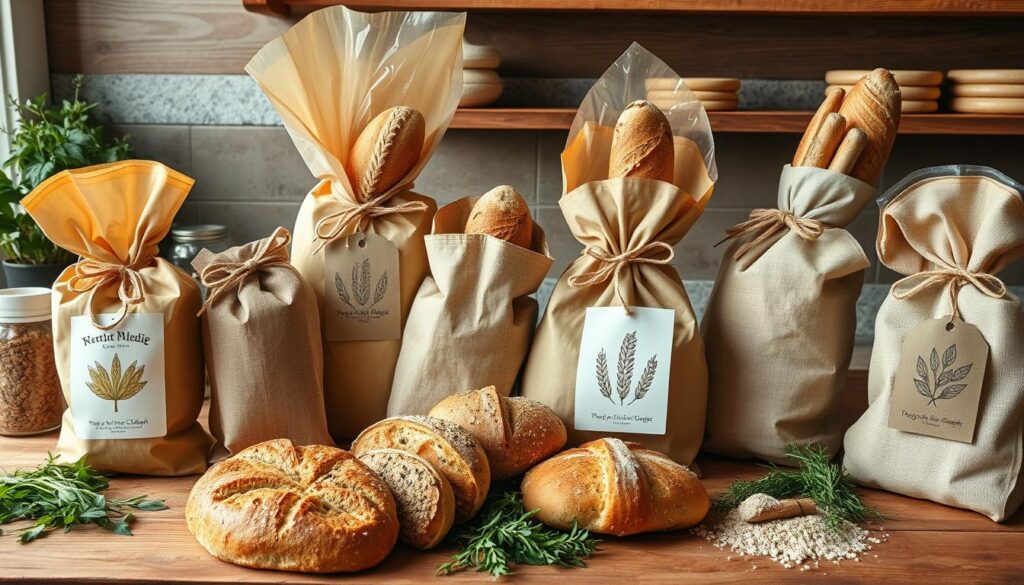
Good bakery packaging ideas often involve unique label sizes and shapes. This grabs the customer’s attention and sets your products apart. Brands with a consistent look across packaging gain more trust. They see a 20-25% rise in recognition.
When creating your labels, think about what matters to your customers. Roughly 70% of them check the nutritional info on baked items. About 60% look for allergen details, so it’s important to list common allergens. Using eye-catching graphics and quality images can also boost engagement by 40%.
You must follow labeling requirements for homemade bread. In Ohio, Home Bakeries need to follow 21 CFR Part 101 for food labels. They also need to include instructions like “Keep Refrigerated” for certain products. Not doing this can harm your business and your customers.
The yearly license for a Home Bakery in Ohio costs only $10. But, it’s crucial to meet all regulations. You can sell your products from your home, in stores, or at farm markets. A professional label approach and quality printing can influence buyers. This matters for around 80% of packaging decisions.
Focus on adding transparent ingredients and sourcing info clearly on your labels. This approach can boost sales by 40% among health-conscious buyers. It builds trust and loyalty with your customers.
Aiming to attract new buyers or keep current ones loyal? Putting effort into bakery packaging ideas and following labeling requirements for homemade bread is key. It’s not just about rules; it’s about connecting with people. Make every bread loaf special.
Managing Orders and Customer Service
Running a successful homemade bread business relies on handling orders well and giving great customer service. This part talks about the best ways to use order management systems. It also gives advice on providing top-notch customer service in the baking business.
Systems for Order Management
A good order management system makes it easier to take, process, and complete customer orders. This is key for businesses wanting to grow. With this system, you can fill orders more correctly and make customers happier.
- Automated Tracking: Use software that tracks orders in real time, from when you get them to when they’re delivered. This reduces mistakes and delays.
- Inventory Management: Use inventory tools with your order system to watch stock levels. This helps avoid making too much or too little product.
- Customer Notifications: Send automatic updates about where their order is. This keeps customers informed and cuts down on their questions.
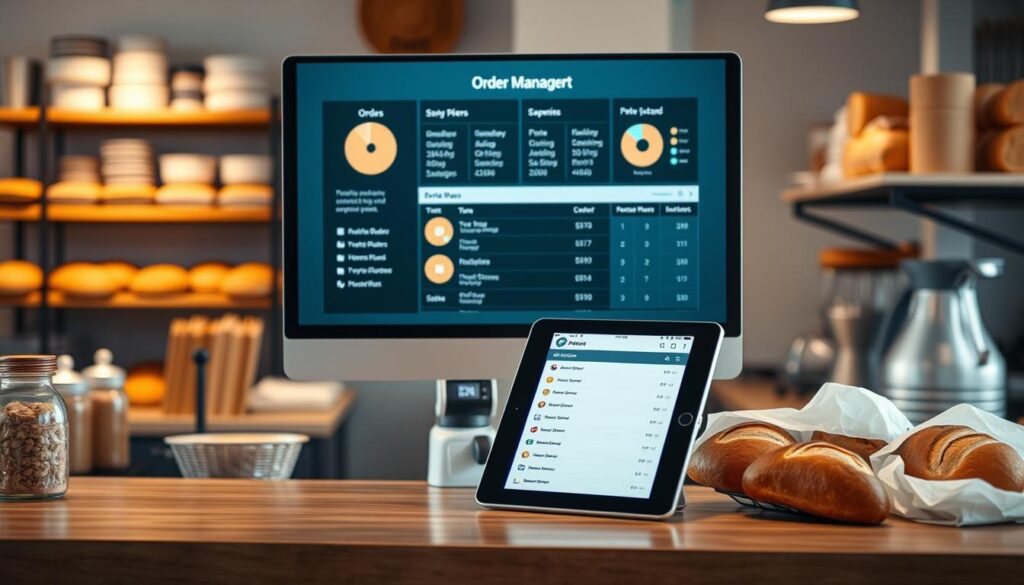
Using order management systems like these helps homemade bread businesses be more efficient and reliable. This leads to loyal customers and more sales.
Tips for Exceptional Customer Service
Great customer service is a must in the baking industry. It builds trust and gets people talking about your business. Here’s how to be the best at customer service in the baking business:
- Personalize Interactions: Remember customers’ names and likes for a more personal touch.
- Timely Responses: Quickly answer any questions, whether through phone, email, or social media.
- Quality Assurance: Make sure all products are top quality. Handle complaints kindly. Offer solutions like refunds or replacements to fix problems well.
Following these tips improves how customers see your business. It also builds a strong reputation. Putting time and effort into good order management systems and customer service in the baking business pays off in the long run.
Scaling Up Your Home Bread Business
Growing your bakery business can be exciting. It offers chances for more customers and profits. To go from a small home setup to a bigger one, look into these tips.
Understanding startup costs is important. They can be between $10,000 and $50,000. Location, equipment, who you hire, and what you bake affect the cost. So, making a thorough business plan is key. It should talk about the market, your money plans, and how you’ll advertise. This plan helps get funding and guides your growth.
Many home bakeries find success by focusing on special markets. Like making gluten-free or artisanal breads. These appeal to people who are health-focused or have diet needs. Using ingredients from your area can attract more buyers. In fact, 41% of consumers say locally sourced ingredients make them more likely to buy.
It’s smart to look into new markets. Start by joining local farmers’ markets and events. This can make more people know about your bakery. Almost 60% of consumers like products made locally. And having special products for a short time has helped 30% of small baking businesses sell more. This keeps customers interested.
It’s also critical to upgrade your kitchen. Getting better baking gear helps you make more without losing quality. Even though bigger bakeries cost more at the start, they can pay off by letting you bake a lot at once.
Expanding your ways to sell is a must. Most successful home bakers, 75% to be exact, say going online and using social media helped them grow. A strong online presence reaches more people, even those not in your area.
Lastly, think about how you’ll handle growing. Every part, from hiring to getting your bread to stores, needs careful thought. Retail bakeries might focus on special items, building a loyal customer base. Food trucks offer a flexible way to reach buyers. Making sure you follow health rules and get the right permits helps avoid fines. This can reduce business problems by 40%.
To sum up, making your home bakery bigger takes planning, exploring new markets, improving your kitchen, getting your name out online, and following the rules. With these approaches, you can grow your bakery, reaching more people and making more money.
Financial Management and Record Keeping
Managing your home bakery finances is key to lasting success. Bakery financial management and exact record-keeping for small businesses can up your profit margins. Know how to handle your cash flow and taxes to make things run smoother and stay legal.
Tracking Expenses and Income
It’s crucial to watch your spending and earnings to keep your bakery healthy. A Point-of-Sale (POS) system helps track sales, manage inventory, and give detailed reports. Here’s what to focus on:
- Initial Costs: This includes the cost of ingredients like flour and sugar, wages, rent, utility bills, advertising, and equipment upkeep.
- Revenue Categories: Make sure to sort your income correctly. This spans product sales like bread and pastries, wholesale deals, and online shopping.
Good accounting helps point out what sells best and when to make key moves. Watch out for seasonal trends and ingredient prices to keep profits high.
Understanding Tax Obligations
Knowing your tax duties is big for bakery financial management. Staying up-to-date with tax rules helps you avoid big fines. Here’s what to remember:
- Record-Keeping: Store all transaction details for easy tax filing.
- Annual Revenue Caps: Home bakeries often face a sales limit, like $50,000, which you must not exceed.
- Business Insurance: A good insurance plan, costing $500 to $2,000 a year, helps cover unforeseen costs.
Smart record-keeping for small businesses means sorting all money matters well for taxes. With a grip on your bakery’s finances, growing it becomes smoother.
Insurance and Liability Considerations
Starting a home-based bakery lets you share your tasty treats with others. It’s also a great way to make money. But, it’s key to protect your baking business by having the right insurance.
Selling food brings risks like customer complaints or legal problems. So, having good insurance is essential. General liability insurance isn’t required by law. Yet, it’s often the first policy bought by small businesses. It helps cover costs from injuries or property damage.
For those running bakeries at home, know this: homeowner’s insurance usually doesn’t cover business activities. You’ll need specific insurance for home food businesses. Product liability insurance is also important. It covers costs if your food causes harm, like allergic reactions or wrong labels.
If you hire people, you might need workers’ compensation insurance. It helps with medical bills and lost wages from work injuries. If you deliver goods, commercial auto insurance is needed for your vehicle. It covers accident costs and theft.
It’s smart to think about business interruption insurance too. If something bad like a fire happens, it covers daily costs until you reopen. Insurance for goods in transit is good for protecting customer orders while they’re being delivered.
When you start your bakery, registering with local authorities and understanding food safety is crucial. Protecting your baking business means following health rules and legal standards, not just buying insurance.
Getting the right insurance is a basic step to keep your business and assets safe. With it, you can focus on making your customers happy with delicious baked goods.
Tips for Long-term Success in the Homemade Bread Business
To succeed long-term in the homemade bread business, blend adaptability, quality control, and active customer engagement. Constantly improving your product quality is key. Use customer feedback to enhance your recipes, ingredients, and methods. This ensures your bread always meets the highest standards.
Being flexible is crucial for sustained success in baking. The food industry changes often, with new trends and customer needs. Stay up-to-date with these trends. If you notice a rise in demand for gluten-free or organic breads, consider adding them to your menu. This can help you attract more customers.
Engaging with your customers is essential to keep them coming back. Use social media and other channels for regular interaction. Run limited-time offers, participate in community events, and refresh your product list often. Having excellent customer service helps you manage orders well and quickly solve any problems.
Financial planning is also vital. Since up to 30% of new food businesses fail in the first year, a solid business plan is necessary. Keep track of your spending and earnings, know your tax duties, and prepare for initial costs ranging from $10,000 to $50,000. A successful bakery is about more than just great bread. It involves managing all business aspects well for growth and profit.

